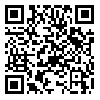Volume 10, Issue 3 (12-2023)
NBR 2023, 10(3): 194-207 |
Back to browse issues page
Download citation:
BibTeX | RIS | EndNote | Medlars | ProCite | Reference Manager | RefWorks
Send citation to:



BibTeX | RIS | EndNote | Medlars | ProCite | Reference Manager | RefWorks
Send citation to:
Jahangiri Zarkani A, Keshavarz M, Shahdadi A. Biological investigation of the barnacle Microeuraphia permitini (Zevina & Litinova, 1970) in Bandar Abbas beach (Persian Gulf) . NBR 2023; 10 (3) :194-207
URL: http://nbr.khu.ac.ir/article-1-3625-en.html
URL: http://nbr.khu.ac.ir/article-1-3625-en.html
Department of Marine Biology, Faculty of Marine Science and Technology, University of Hormozgan, Post Box: 3995 Bandar Abbas, Iran , m.keshavarz@hormozgan.ac.ir
Abstract: (4905 Views)
Barnacles are bottom-dwelling crustaceans that live on a variety of substrates, including rocks, mollusk shells, corals, sponges, mangrove roots and leaves, and the body surface of turtles and whales. The present study deals with the species Microeuraphia permitini on the shores of Bandar Abbas in two stations of mangrove forest and rocky beach in a period of two months, and has investigated the morphometrics of the specimens, while considering the effect of the lunar cycle on reproduction, temperature and wind speed of the environment. Five longitudinal parameters (height, basal length and width, opercular length and width) were recorded. The results showed that 90% and 70% of the samples of both stations had eggs in the second day (new moon) and eighth days of lunar months, respectively, and in the twelfth day of the lunar month (full moon) all samples contained eggs. The results showed that there is a significant difference between the height and base length of the barnacle, but the difference between the opercular length, opercular width and base width is not significant. In addition, in both of mangrove and rocky stations, there was the highest correlation coefficient between opercular length and width (r=0.84 and r=0.78, respectively). The lowest correlation coefficient in mangrove station was between base length and opercular width (r=0.5) and in rocky station between height and base width (r=0.2). The wind pattern was variable during this period and the approximate decrease of the north wind was seen during the sampling period. Air temperature changes were seen between minimum 30 °C and maximum 39 °C. In addition to the tidal cycle, wind and temperature can affect the spawning of the species as an environmental stress factor.
Type of Study: Original Article |
Subject:
Ecology
Received: 2023/05/13 | Revised: 2023/12/21 | Accepted: 2023/08/27 | Published: 2023/12/20 | ePublished: 2023/12/20
Received: 2023/05/13 | Revised: 2023/12/21 | Accepted: 2023/08/27 | Published: 2023/12/20 | ePublished: 2023/12/20
Send email to the article author
| Rights and permissions | |
 |
This work is licensed under a Creative Commons Attribution-NonCommercial 4.0 International License. |





